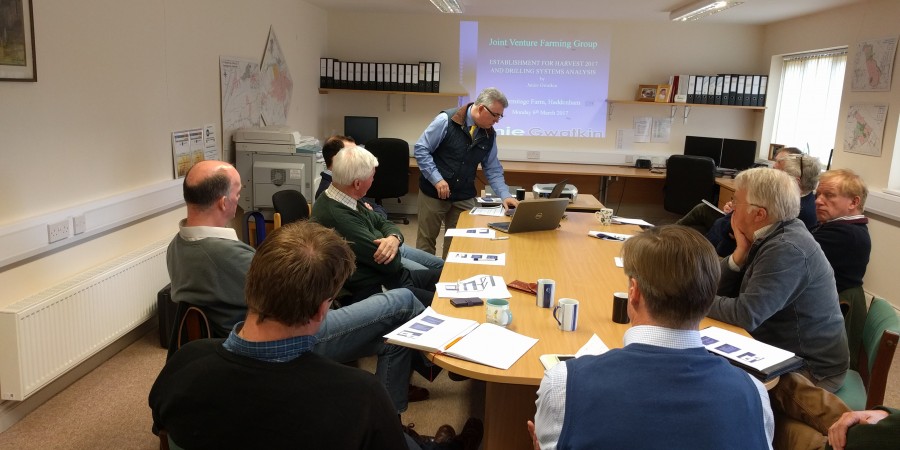There has been a steady downward progression in costs for each farm involved in JVFG benchmarking. That was the news headline for the member JVFG farms at their recent spring meeting. This time the host farm was AG Wright and Son (Farms) Ltd, Haddenham, Cambridgeshire. Members heard the latest JVFG benchmarked results: the costs of establishment across all JVFG member businesses.
Trends, crops and drops
Yes, thanks to autumn 2016 weather conditions being generally dry, higher work rates had a knock-on effect of reducing costs. However JVFG consultant Jamie Gwatkin, with his usual in-depth analysis, highlighted many more lessons to be noticed in the numbers.
Winter barley and winter oilseed rape seem to be linked. The acreage planted with these crops has dropped. But spring barley area has increased as growers look to lower their financial exposure.
Cultivation matters
With primary cultivation, it was noticeable that Essex-based Granta Farming, who have a plough-based system, struggle to plough in very dry conditions. This has led them to use a Patriot cultivator with higher work rates and lower running costs.
As regards to secondary cultivation, probably the largest change seen was at Brixworth Farming of Northamptonshire as they move to a direct drilling system. Much higher work rates have been achieved reaching as high as 6.2 hectares an hour. This has led to a secondary cultivation cost of £9.60 per hectare.
When combining primary and secondary cultivation together
There is a clear differentiation between plough-based and direct drilling systems. Plough-based Granta Farming are achieving £31 per hectare. Stoke Farms and
Brixworth Farming, who are closer to the direct drilling end of the spectrum, are achieving £14.58 a hectare and £10.91 respectively.
Drilling costs
With the move to direct drilling, it is noticeable that drilling costs increase. Stoke Farms of Buckinghamshire achieved just over £35 /ha compared to a group average of just under £22/ha with a work rate of 2.26 ha/hr. While the lowest was a cultivator system at Manor Farm, Oxfordshire, with just over £14/ha as a result of higher work rates of 3.49 ha/hr as compared to an average work rate across the group of 2.84 ha/hr.
Crawlers vs tractors: more evidence of comparative costs
Crawlers proved once again that they are more expensive to run than conventional tractors. With increasing horsepower of conventional tractors it looks likely that members will continue to invest in wheels over tracks, even for high horsepower machines.
Back to best farming practice
JVFG members return to the farming of the season feeling that, yet again, the data has demonstrated large variations in costs. This means there is still scope for improvement.
The full picture of machinery running costs will only become clear when cost per tonne is calculated at next analysis meetings scheduled for early summer and autumn 2017. However, in the meantime, all JVFG members are heartened that for all of them the overall trend is that costs are being pushed downwards.

